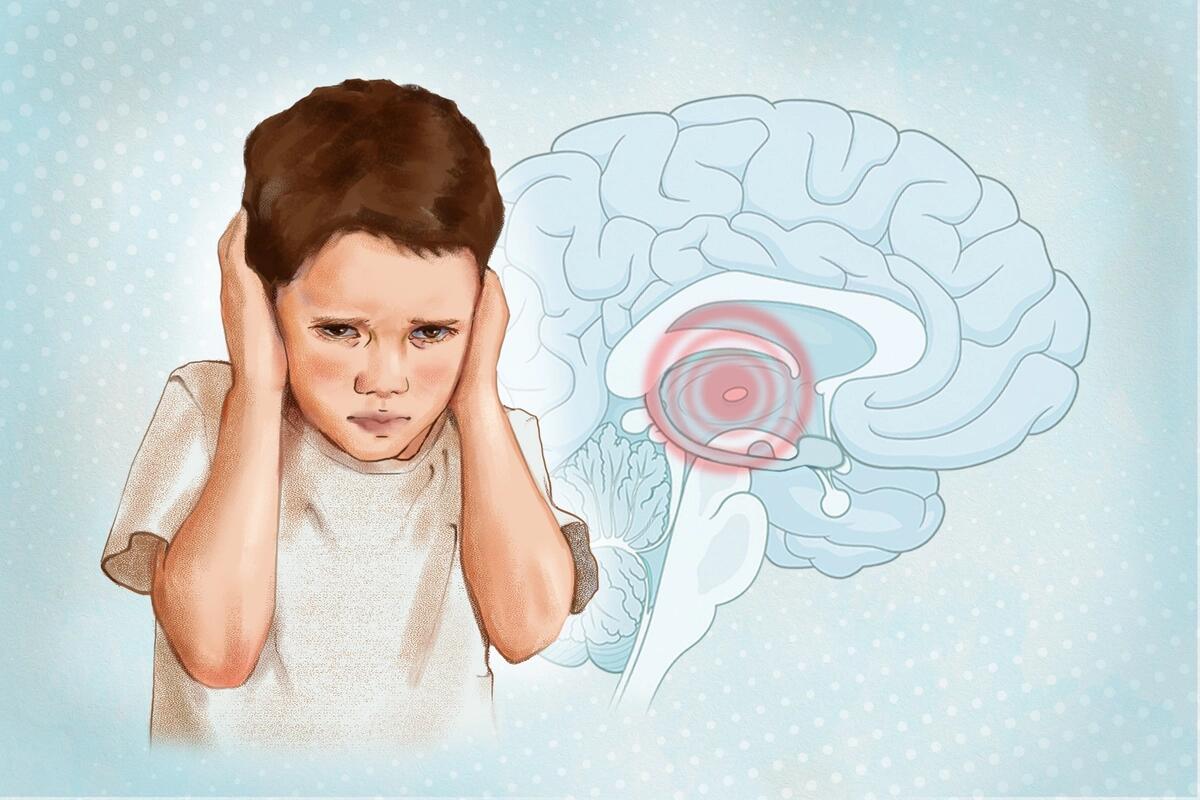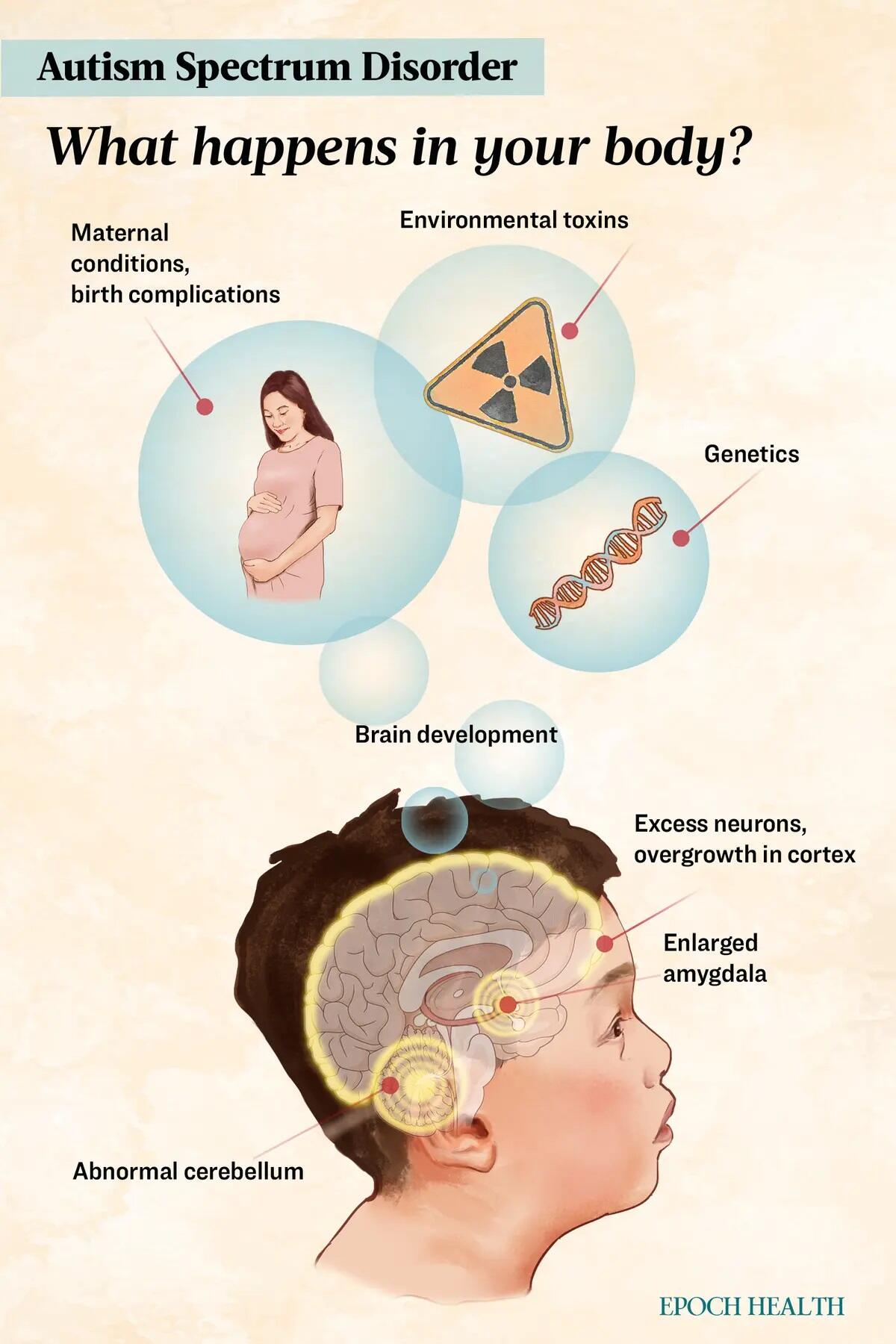Autism Spectrum Disorder: Symptoms, Causes, Treatments, And Natural Approaches
Authored by Mercura Wang via The Epoch Times (emphasis ours),
Autism spectrum disorder (ASD), or just autism, is a neurological and developmental condition that affects social interaction, communication, learning, and behavior. It encompasses a range of conditions related to brain development.

Globally, around 1 percent of children have autism. In the United States, however, one in 36 children and one in 45 adults have autism, with the condition affecting around 4 percent of boys and 1 percent of girls. The prevalence is up from one in 44 in 2020 and has almost tripled since 2000 when it was one in 150.

What Are the Symptoms and Early Signs of Autism?
“On the spectrum” refers to individuals who share core characteristics of autism while recognizing that each person’s autistic experience is unique, complex, and can change over time.
Thinking about autism as on a linear spectrum can be misleading, as it suggests a person can have “more” or “less” autism, leading to oversimplified labels such as “higher” or “lower functioning.” Instead, autism is better understood as a range of diverse traits, strengths, and challenges that vary for each individual.
Early Signs
The first signs of autism typically appear in early childhood and can be detected through screening in children as young as 12 months old or as old as 24 months. However, the condition may be missed until much later.
Early signs of ASD by age include the following:
- 6 to 12 months: Limited smiling, eye contact, or reciprocal social interactions; diminished babbling or gestures; and reduced response to name
- 9 to 12 months: Repetitive behaviors (e.g., spinning and lining up objects) and unusual play (intense focus on toys’ visual or tactile features)
- 12 to 18 months: Lack of single words, compensatory gestures (e.g., pointing), and pretend play; and limited joint attention (initiating and sharing interests)
- 15 to 24 months: Little to no spontaneous two-word phrases
Signs and Symptoms
The following are common behaviors observed in individuals with ASD. While not all autistic individuals exhibit every behavior, most will show several traits. Some of these behaviors can also occur in people without ASD.
Social interactions:
- Minimal or inconsistent eye contact with others
- Appearing disinterested or inattentive when others are speaking
- Rarely sharing enthusiasm or feelings about objects or activities
- Avoiding physical affection and preferring solitary play, often withdrawing into their own world
- Not responding or taking a long time to respond when called by name
- Limited or delayed speech or loss of previously acquired words
- Struggling with the give-and-take aspect of conversations
- Echoing words or phrases without grasping their meaning
- Having trouble comprehending basic questions or instructions
- Relying on memorized scripted speech instead of using spontaneous language
- Using pronouns incorrectly, such as saying “you” instead of “I” or “me” when referring to themselves
- Talking extensively about specific topics without recognizing others’ disinterest or allowing them to contribute
- Using facial expressions and gestures that are inconsistent with their verbal messages
- Exhibiting an unusual voice quality, such as a sing-song or monotone
- Struggling to grasp others’ perspectives or anticipate their behavior
- Showing little emotional expression and appearing unaware of others’ emotions or exhibiting abnormal expressions of empathy
- Struggling to understand nonverbal cues such as body language or tone of voice
- Not developing close personal relationships, especially outside the family
- Lack of speech, in severe cases
- Taking things very literally, such as not understanding sarcasm or expressions such as “it’s raining cats and dogs”
Restrictive or repetitive behaviors:
- Stimming (self-stimulating behaviors), which involves repetitive body movements or the manipulation of objects. While common among autistic individuals, it is a behavior that nearly everyone exhibits in some form, such as nail biting. For autistic people, stimming can occasionally interfere with daily life or cause harm but often serves as a coping mechanism for managing sensory overload or stressful situations.
- Establishing rigid routines or rituals and becoming upset with even minor changes.
- Experiencing coordination issues or displaying unusual movement patterns, such as clumsiness, toe-walking, or exaggerated body language.
- Displaying severe tantrums or emotional outbursts.
- Fixating on a single topic or activity or maintaining a deep, enduring interest in particular subjects such as numbers or facts.
- Showing limited attention span.
- Picky eating, such as preferring only a few foods or avoiding certain textures.
- Showing heightened or diminished sensitivity to sensory stimuli such as light, sound, clothing, or temperature.
- Developing an intense attachment to specific inanimate objects.
- Having highly specialized and sometimes unusual interests (e.g., intense fascination with vacuum cleaners).
People on the autism spectrum often have notable strengths, such as the ability to learn and retain detailed information, strong visual and auditory learning skills, and excellence in memory, math, science, music, or art. They may also notice subtle details, patterns, smells, or sounds that others may overlook.
Autism Signs in Females
Autism symptoms in women and girls may be different from those in males. According to the DSM-5-TR, autistic females may exhibit:
- Enhanced reciprocal conversation skills
- Improved understanding of verbal and nonverbal communication
- Greater ability to adapt their behavior to different situations
- Less noticeable repetitive behaviors
- More socially accepted special interests (e.g., celebrities)
Research indicates that females are more likely to mask their autism symptoms to fit in than males. They may stay close to peers and move in and out of activities, regardless of engagement status.
What Causes Autism?
Research indicates autism arises from a combination of genetic and environmental factors, as well as abnormal brain development.
Genetics
Genetic factors are believed to contribute 40 percent to 80 percent of autism risk. Over 1,000 genes have been linked to ASD, although many associations remain unconfirmed. Common gene variations may increase ASD risk, but most have a small individual effect, and not everyone with these variations develops ASD.
In about 2 percent to 4 percent of cases, rare gene mutations or chromosomal abnormalities are a direct cause, as with ADNP syndrome, also known as Helsmoortel-Van der Aa syndrome (HVDAS). Some other genes whose rare mutations are associated with autism include ARID1B, ASH1L, CHD2, CHD8, DYRK1A, POGZ, SHANK3, and SYNGAP1. Many ASD-associated genes play roles in brain development or regulate other genes or proteins.
In some children, autism may be linked to a genetic condition such as fragile X syndrome or Down syndrome.
Brain Development
Research suggests that during brain development, individuals with ASD may have an excess of neurons and overgrowth in parts of the brain’s outer layer, the cortex. Additionally, there are irregular areas where the typical structure of the cortex is disrupted. The cortex normally has six layers, formed before birth, each with specialized neurons and connections. These abnormalities are seen in the frontal and temporal lobes, regions involved in emotions, social behavior, and language. These differences are believed to contribute to the social, communication, and cognitive challenges associated with autism.
Other parts of the autistic brain that exhibit abnormalities include the cerebellum and the amygdala. However, it is unclear whether these brain changes spur autism or vice versa.
Environmental Factors
Environmental factors can range from infections and diseases to toxins and maternal health during pregnancy. They include:
- Certain diseases: An ASD subtype called childhood disintegrative disorder is associated with certain diseases, especially if it is late-onset, including subacute sclerosing panencephalitis (a chronic brain infection caused by a measles virus form), tuberous sclerosis (a genetic disorder characterized by benign tumor formation in the brain and other organs), leukodystrophy (a condition involving maldevelopment of the myelin sheath, leading to the disintegration of white matter in the brain), and lipid storage diseases (disorders where excessive fat accumulates in the brain and nervous system, causing toxicity).
- Prenatal infections: Examples include rubella and cytomegalovirus infections.
- Maternal immune conditions: Maternal immune conditions increase autism risk in children. A 2020 study found that maternal asthma was the most frequently reported in mothers of children with ASD. Autistic boys were more likely to have mothers with a history of immune conditions than girls with ASD.
- Prenatal exposure to air pollution: Exposure to PM2.5 (particulate matter that is 2.5 micrometers or smaller in diameter) during the first two trimesters of pregnancy was linked to a higher risk of ASD in children, especially boys.
- Exposure to toxins in the womb: Being exposed to toxins (e.g., heavy metals) or medications (e.g., antidepressants, valproic acid, and thalidomide) while in the womb or in early childhood could raise the risk of autism.
- Lower levels of manganese and zinc.
- Maternal diabetes and obesity: Maternal preexisting Type 2 diabetes, Type 1 diabetes, and gestational diabetes diagnosed by 26 weeks of pregnancy are linked to a higher risk of ASD in children. A 2016 study found that children born to obese women with diabetes are over three times more likely to be diagnosed with autism compared to children of mothers with a healthy weight and no diabetes.
- Birth complications: Preterm birth may increase the risk of ASD, with a higher risk associated with greater levels of prematurity. Challenges during birth resulting in episodes of oxygen deprivation to the baby’s brain can also increase the risk.
- Assisted reproductive technology: A 2017 study suggested that the use of assisted reproductive technology (e.g., in vitro fertilization) may be associated with an increased risk of autism in children.
- Paternal cannabis use: A 2019 study found that a gene linked to autism, DLGAP2, can change in the sperm of men who use cannabis. These changes in the gene’s DNA could be passed down to future children, possibly affecting their autism risk.
Childhood Vaccines
Although authoritative organizations such as the World Health Organization (WHO), the American Academy of Pediatrics (AAP), and the U.S. Centers for Disease Control and Prevention (CDC) assure parents that there is no link between childhood vaccines and autism, some scientists call for further study.
Read more here...
NEVER MISS THE NEWS THAT MATTERS MOST
ZEROHEDGE DIRECTLY TO YOUR INBOX
Receive a daily recap featuring a curated list of must-read stories.


